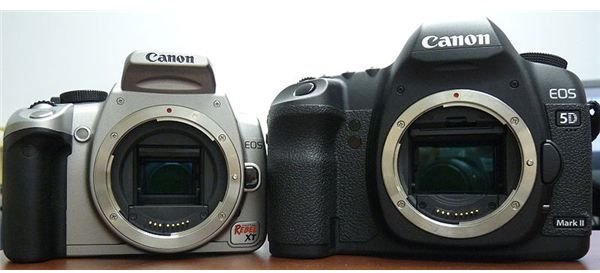What is the Difference Between a Full Frame Digital Camera and a Cropped Sensor Digital Camera?
Is Bigger Better?
When shopping for a new DSLR, you may have noticed that some of the bodies are considerably larger than others, and the larger ones tend to be a lot more expensive. Often, the reason for this is that the larger ones are full frame and the smaller ones are not. What does this mean?
The size of the sensor a camera uses is measured compared to 35mm film. Consumer-level DSLRs and pocket cameras use a sensor which is somewhat smaller than film; these are called cropped sensor digital cameras. Full frame digital cameras, on the other hand, use a sensor the same size as 35mm film. A full frame digital camera and a cropped sensor digital camera may have the same number of megapixels, but the pixels on the full frame camera will be larger, which usually results in a better photo.
So does this mean that a full frame camera is always better? Well…no. Each camera type has its own advantages and disadvantages, as we’ll see in the following sections.
Cost
The largest factor, for most people, will be cost. Full-frame cameras cost more - a lot more. For example, Nikon offers two cameras - the D300s and the D700 - which use the same camera body. Both are 12MP. At the time of this writing, the D300s costs $1449 from Amazon and the D700 costs $2349 from Amazon - quite a difference!
Of course, any serious photographer knows that the lenses are where the real money is! Lenses for full frame sensors (and film) need to cover a larger space, so they also cost more than the corresponding lenses for a cropped sensor camera. Given that professional quality lenses can run into thousands of dollars, this can make a very large difference.
Size and Weight
Of course, the smaller camera and lenses are just that - smaller, and lighter! This means they can be a lot easier to carry around. At one extreme, you can easily find a cheap digital camera that slips into your pocket and carry it around everywhere; you probably won’t be doing that with your DSLR! Having smaller, lighter lenses makes it a lot easier to always have what you need with you without getting tired from carrying all those heavy lenses around.
Indeed, professional lenses often get so large that you attach the tripod to the lens and the camera hangs from the tripod, rather than the other way around!
Speed
In general, a cropped sensor digital camera will be faster than the equivalent full frame digital camera. Continuing the earlier example, the D300s shoots at 7 frames per second, while the much more expensive D700 shoots only 5 frames per second (although both cameras can be boosted to 8 fps with the addition of an optional battery pack).
For photographers who need to take a number of shots in quick succession, the improved speed of the cropped sensor cameras can be a deciding factor. However, for those who prefer to compose each shot carefully or like to use slow shutter speeds, the difference may not be particularly important.
Picture Quality
Face it: these days, you can get perfectly good photos from a cheap pocket camera. However, if you want the absolute best quality available from a digital camera, you want big pixels, which means going full frame. Most people will never even notice the difference, but for those who need it (in other words, professionals who will be blowing up their prints to billboard size), the larger pixels offered by full frame cameras make them a necessity.
Compatibility
Often, when choosing a camera brand, the deciding factor is not the relative merits of Canon vs. Nikon, but the number of good lenses one already owns. As film lenses work perfectly well with full frame digital cameras, film photographers will often want to go with full frame simply to be able to continue getting the full value out of their old lenses.
Which camera is right for you?
